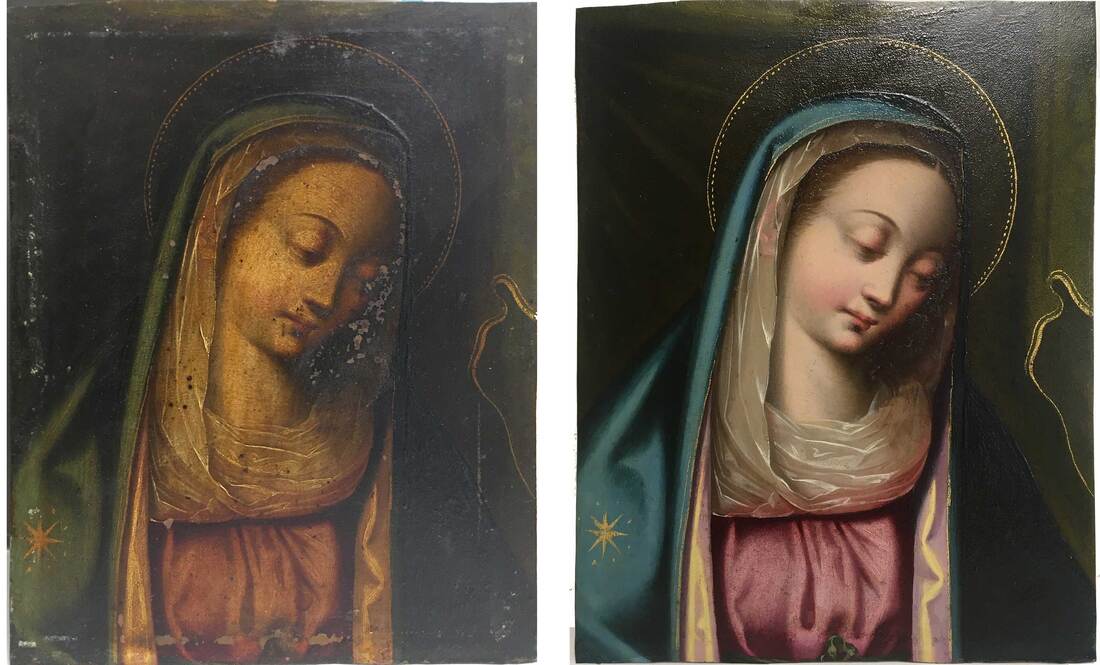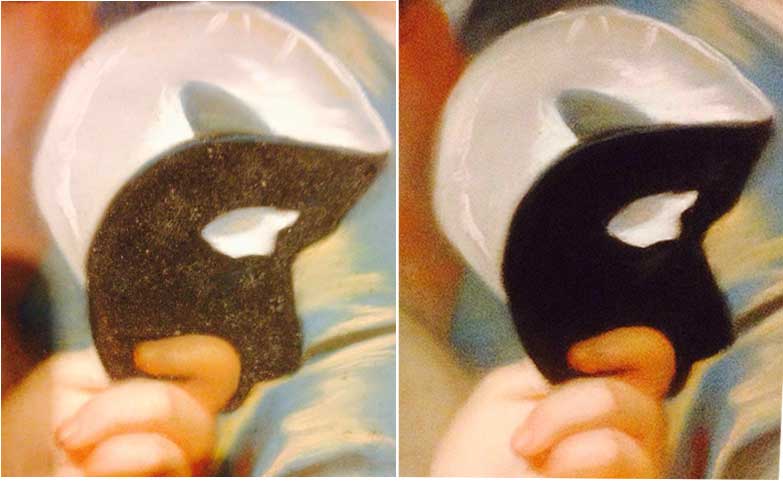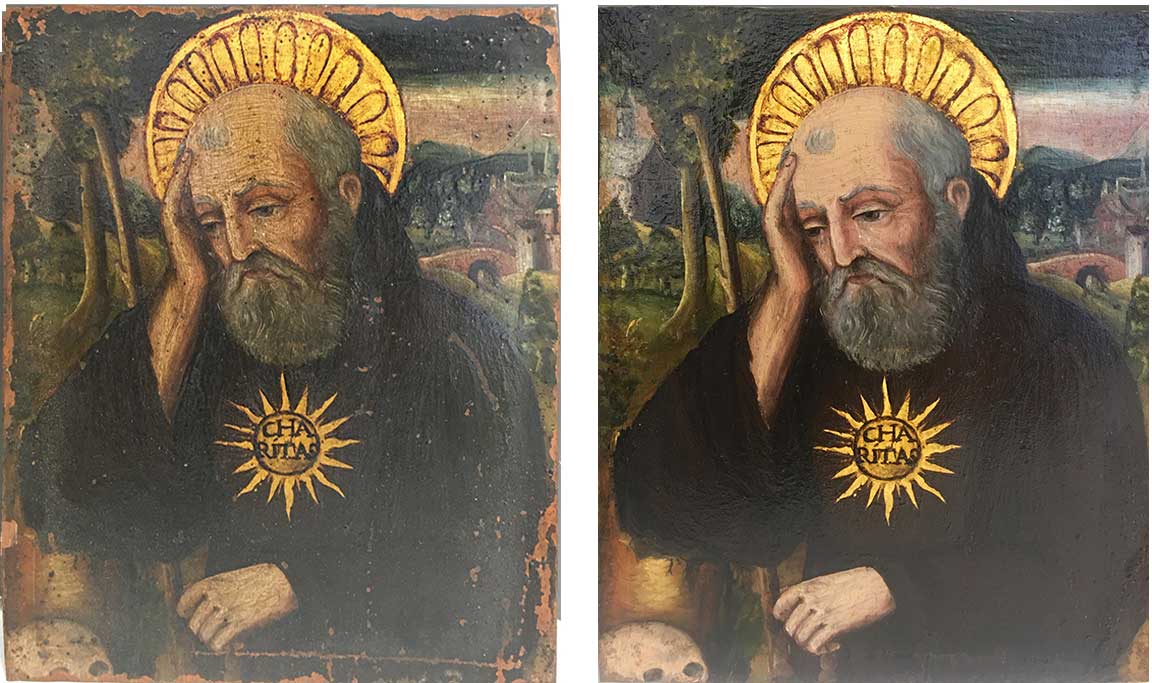Examples of art conservation and restoration
The Art Doctor treats a wide range of artworks including modern and contemporary paintings, Old Master works and sculpture.
Art conservation and restoration is a specialised profession where each piece is treated with equal respect whether a family heirloom, the pride of your collection or an investment piece.
Art conservation and restoration is a specialised profession where each piece is treated with equal respect whether a family heirloom, the pride of your collection or an investment piece.
Before and after treatment examples:

A wonderful small oil painting on copper from the mid 18C was given a new lease of life with the removal of old varnish and age spots. The losses were filled and retouched and a new stable synthetic varnish to protect her for at least another 100 years.
Copyright: The Art Doctor 2021
Copyright: The Art Doctor 2021

The gilded frame of this little oil on paper seascape had been painted with bronze paint, the varnish on the painting was yellowed and dark and the linen insert was stained and warped. After cleaning the frame and removing the horrible overpaint, replacing the linen insert and removing the old yellowed varnish from the picture, the scene from Greenland in 1894 was given a new lease of life.
Copyright: The Art Doctor
Copyright: The Art Doctor
An unvarnished oil on canvas board, circa 1930, had been exposed to environmental pollutants, including cigarette smoke and benefitted greatly from careful cleaning. The vibrancy of the painting's true colours was unexpected, an absolute gem!!
Copyright: The Art Doctor
Copyright: The Art Doctor
An oil on cardboard painting (detail shown) had a seriously aged, discoloured varnish and was bent out of plane.
The distortions were corrected, varnish removed, losses and tears repaired, re-touched and re-varnished.
The Art Doctor only uses reversible synthetic museum-grade varnishes which will not yellow over time the way traditional dammar and copal varnishes can.
Copyright: The Art Doctor
The distortions were corrected, varnish removed, losses and tears repaired, re-touched and re-varnished.
The Art Doctor only uses reversible synthetic museum-grade varnishes which will not yellow over time the way traditional dammar and copal varnishes can.
Copyright: The Art Doctor
This small, unattributed, Spanish oil on paper was covered in accumulated surface grime, extremely fragile and was cracked and out of plane. It was successfully cleaned, flattened and mounted onto archival board ready for reframing.
Copyright: The Art Doctor
Copyright: The Art Doctor
Untitled (View of Capri from Sorrento) by Solari, circa 1895, was dirty, had yellowed varnish, old hole and tear repairs, was buckled and the frame had suffered losses and required cleaning and reconstruction work. The painting and frame are now in a stable condition, clean and bright and will last another 100 years or more before requiring a new varnish. The Art Doctor always applies protective backing boards to works on canvas to protect them from environmental, pest and accidental damage.
Copyright: The Art Doctor
Copyright: The Art Doctor
An unusual wall sculpture/collage by Richard Larter from 1971 made from timber scraps, graphite pencil drawing, and wax on board had been poorly stored for over three decades. Dust and ingrained dirt was removed, losses and broken parts replaced. The drawing of the artist's wife Pat came up particularly well.
Copyright: The Art Doctor
Copyright: The Art Doctor
Detail from a pastel on silk laid on cardboard showing partial cleaning on left, and full clean on right. This French piece from the late 18C was mould affected and the pastel had become scattered over time through movement during transport and static electricity making the pastel stick to the glass glazing. Careful cleaning revived the original colours.
Copyright: The Art Doctor
Copyright: The Art Doctor
A delightful little oil on copper panel painting dating from the 17C looks super after removal of old yellowed varnish, then the reduction of disfiguring black spots and eruptions caused over time by the formation of metal soaps in the paint. The losses caused mainly by frame abrasions were in-painted before a new coat of museum-grade varnish was applied.
Copyright: The Art Doctor
Copyright: The Art Doctor
Natural varnishes were designed to protect the painting from dirt, grime, scratches and light damages. Traditional varnishes made from plant resins can begin to yellow within 30 or so years depending on how much light they are exposed to. This painting from 1881 had been kept very well and as you can see, the varnish removal made a big difference to what the artist originally intended. A new museum grade varnish was applied and will last around 100 years.
Copyright: The Art Doctor
Copyright: The Art Doctor







